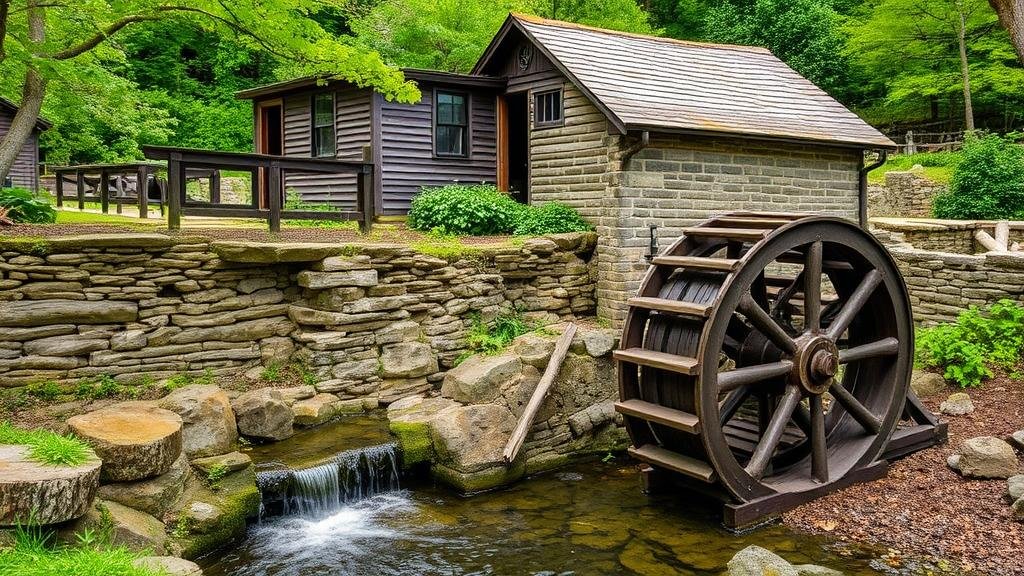Rediscovering Relics in Forgotten Waterwheel-Powered Mill Locations
Introduction
The legacy of waterwheel-powered mills holds a significant place in the history of industrial transformation, particularly in the United States during the 18th and 19th centuries. These relics are not only vital to understanding historical manufacturing practices but also serve as cultural monuments that exemplify human ingenuity in harnessing natural resources.
Historical Significance of Waterwheel-Powered Mills
Waterwheel-powered mills were once the backbone of local economies, facilitating the processing of grains, textiles, and other commodities. A prime example is the Gristmill in Stonington, Connecticut, established in 1761, where the combination of natural water flow and mechanical technology resulted in a significant increase in productivity.
The Technological Revolution
The introduction of waterwheels marked a pivotal moment in the development of mechanized agriculture. e structures convert the kinetic energy of flowing water into mechanical energy to perform useful work. The waterwheel’s design evolved from the simple undershot wheels to the more effective overshot and breastshot models, enhancing efficiency as reported by R. S. Cline in his 1997 study on the mechanics of early American mills.
Economic Impact
According to data from the U.S. Census Bureau, by the mid-1800s, more than 25% of all manufacturing in the United States was conducted in mill towns where waterwheels were the primary power source. These towns developed unique economic systems reliant on milling–turning raw agricultural products into items ready for market.
Rediscovery Initiatives
In recent decades, several initiatives have emerged to rediscover and preserve watermill sites. Organizations such as the American Society of Mechanical Engineers (ASME) have highlighted the importance of these relics. Restoration projects not only serve educational purposes but also foster tourism and local economies.
Conservation Efforts
One notable example is the “Mills of New England” initiative launched in 2010, aimed at restoring significant mill sites across the New England region. This program has successfully rehabilitated 15 sites, including the historic Washington Mill in Massachusetts, which now serves as a museum and educational center.
Community Engagement
Local communities are increasingly involved in preserving mill sites through heritage festivals and educational workshops. In 2021, the Watermill Festival in Pennsylvania attracted over 5,000 visitors, highlighting the ongoing interest in mill history and culture.
Challenges to Preservation
Despite significant efforts to preserve these structures, challenges remain. Many watermills have succumbed to natural deterioration, neglect, and development pressures. A survey conducted by the National Trust for Historic Preservation in 2020 revealed that over 60% of the existing watermill sites are at risk due to urbanization and environmental factors.
Funding and Resources
Securing funding for restoration projects can be difficult. Grants from historical preservation organizations like the National Park Service can be competitive, and many mills struggle to meet the financial requirements necessary for application. An example of successful funding is the $500,000 awarded to restore the Enfield Falls Mill in New York in 2019.
Environmental Concerns
The environmental impact of water removal and habitat alteration also poses concerns. The Pennsylvania Fish and Boat Commission reported a decline in local fish populations in areas where waterwheels divert significant quantities of water, prompting regulations on water usage for mill operations.
Real-World Applications
Rediscovering and restoring waterwheel-powered mills can serve multiple purposes: educational, environmental, and economic. Mills can be integrated into local educational programs, offering students hands-on learning experiences in history and engineering.
Educational Partnerships
Partnerships between universities and mill sites can foster academic research and community development. For example, the collaboration between the University of Vermont and the WaterWheel Preservation Society resulted in the “Mill Restoration Project,” focusing on both historical documentation and modern ecological considerations.
Sustainable Tourism
Developing heritage tourism can enhance local economies. The State of New Hampshire reported that visitors to mills contribute over $1 million annually to the local economy, emphasizing the profitability of well-preserved sites.
Conclusion
Rediscovering relics of waterwheel-powered mills presents both opportunities and challenges. Engaging communities in preservation efforts can revitalize interest in these historical structures, leverage their educational potential, and promote sustainable tourism. Prioritizing such initiatives will ensure that these important cultural and technological landmarks are preserved for future generations.



